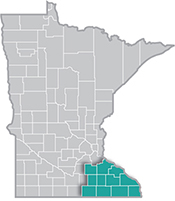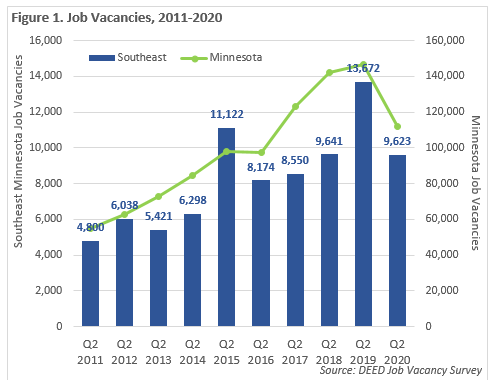 Southeast Minnesota is a health care and agricultural powerhouse. The region is home to the renowned Mayo Clinic and some of the world's most recognized food companies and brands.
Southeast Minnesota is a health care and agricultural powerhouse. The region is home to the renowned Mayo Clinic and some of the world's most recognized food companies and brands.
Advanced manufacturing is especially strong here, with machinery, chemicals, and electronics among the top products.
Want the freshest data delivered by email? Subscribe to our regional newsletters.
12/4/2020 9:00:00 AM
After seeing the biggest increase in job vacancies of any region in the state from the second quarter of 2018 to the second quarter of 2019, Southeast Minnesota saw the second biggest decline in job vacancies from the second quarter of 2019 to the second quarter of 2020. After reaching a record high of 13,672 job vacancies last summer, employers in the region posted 9,623 vacancies this summer, nearly matching the number in 2018. Southeast saw a 30% decline, outpacing the 24% decline statewide (see Figure 1).

The coronavirus pandemic led to a shift in hiring demand in the region, with employers reporting nearly 1,600 fewer openings in the hard hit Accommodation & Food Services industry, and about 1,100 fewer vacancies in the Manufacturing industry. Easily the largest employing industry in the region, Health Care and Social Assistance also saw about 1,000 fewer job postings in 2020 than in 2019, but still had the largest number of vacancies with just over 2,150 current openings.
Several smaller industries also saw big percentage declines, including Public Administration, Transportation & Warehousing, Wholesale Trade, Finance & Insurance, Agriculture, and Administrative Support & Waste Management Services – which includes temporary staffing agencies.
In contrast, Retail Trade saw a more measured decline in job postings, and still had over 1,650 vacancies in the second quarter of 2020. Educational Services also suffered only a slight decline in openings. White-collar workers were in demand in both Professional & Technical Services and Information, which both saw a yearover-year increase in job vacancies in Southeast (see Figure 2).

The good news for job seekers is that in the second quarter, there were still over 9,600 jobs available in the region, which is near the record levels reached prior to last summer; and wage offers were rising for most industries. The median hourly wage offer across all industries climbed to $15.20, up from $14.38 in 2019, a 5.7% increase. For example, to attract workers in the Accommodation & Food Services industry, employers raised the median wage offer by $1, to $11.98. Likewise, wage offers were up almost a dollar in Retail Trade, to $13.18.
However, the median wage offer in Health Care & Social Assistance fell almost $0.50, due in part to the drop in vacancies overall, and the higher share of lower-skilled, lower-paying health care support occupations in demand, such as home health aides and certified nursing assistants, rather than higher-level health care practitioners such as RNs, doctors and dentists. The irony of the pandemic was the decline in demand for some health care workers, although that seems to have reversed in the fall and early winter as COVID-19 cases surged across the region. Home health aides and personal care aides had the highest number of vacancies, while RNs currently lead the list of jobs in demand.
Contact Mark Schultz.